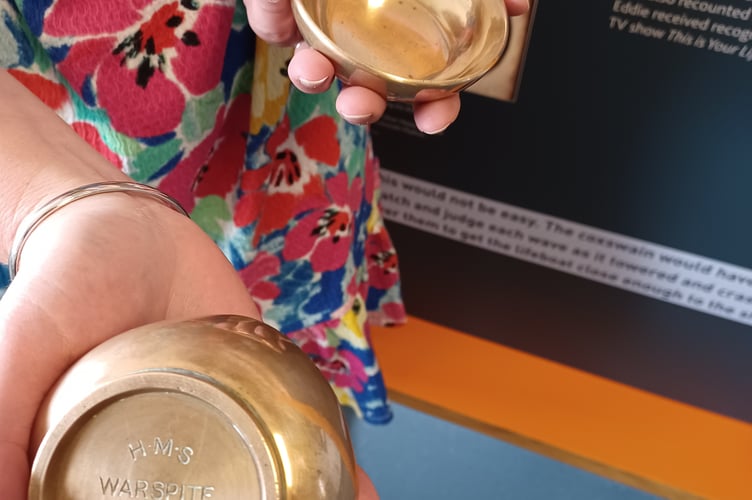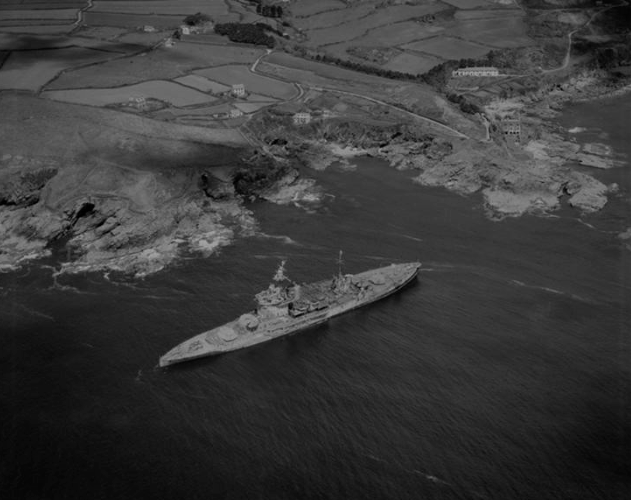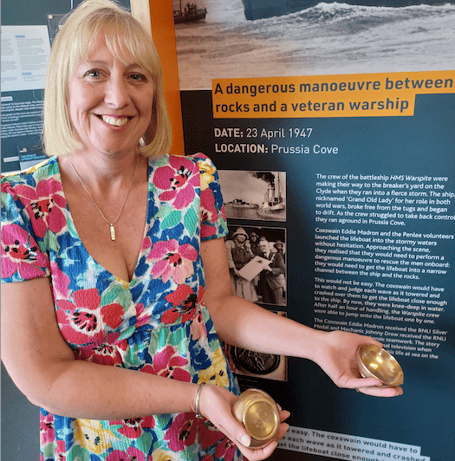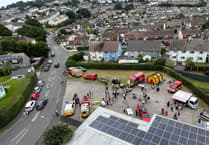TWO bronze ashtrays salvaged from a former warship that was wrecked at Prussia Cove have been donated to Penlee RNLI to mark the bravery of the lifeboatmen who saved the lives of eight crew members.
Charlotte Lilley kindly donated the artefacts from HMS Warspite to Andy Bramwell RNLI community manager for Cornwall for display at Penlee Lifeboat station’s visitor centre.
Her grandfather rescued the ashtrays from a scrapyard in Wolverhampton, and the family kept them as heirlooms.

Charlotte’s family were always huge supporters of the RNLI despite growing up away from the sea.
Her husband, David, began working in the RNLI’s face to face fundraising team a few years ago, and came on a training day at Penlee lifeboat station.
He noticed the HMS Warspite rescue story in the visitor centre and remembered Charlotte’s two ashtrays, inherited from her grandmother.
Charlotte decided to donate the ashtrays to the RNLI to go on display in the visitor centre to help tell the story of the rescue and complete the ashtrays’ journey from Cornwall to Wolverhampton and back to Cornwall.

It was on April 23, 1947, that the 31,000-ton former battleship, HMS Warspite crashed against the rugged Cornish cliffs in storm conditions whilst on tow to Glasgow.
At the helm of the Penlee Lifeboat ‘W and S’ for the first time, coxswain Edwin (Eddie) Madron handled his craft with such skill that all eight men were able to make the dangerous leap without injury.
Coxswain Madron was awarded the silver medal of the RNLI and mechanic Johnny Drew received the bronze medal.
The remaining crew, Abraham Madron, Joe Madron, Ben Jeffery, Clarry Williams, Jack Worth, Luther Oliver, Jack Wallis, and Charlie Edmonds all received the thanks of the RNLI on vellum.
The Yorkshire Post and Leeds Intelligencer wrote at the time: “With 25 foot waves beating over the hulk, the crew's peril was grave, and the Mousehole (Penlee) lifeboat at once set out again to accomplish one of the finest rescues this coast has seen.
“Cheered by the people looking down from the 200 feet cliffs, the coxswain, Edwin Madron, daringly brought the lifeboat alongside the Warspite, got two lines aboard her, and by skilful use of his engines kept in position while the eight men of the skeleton crew leaped across, one by one.
“It was a test of seamanship and a test of nerves, for the men had to time their jumps to a second as the lifeboat rose level with the warship's decks on the 25-foot breaking seas.
“Captain Baxter said ‘We should never have got off but for the skill of the life-boatmen. “They knew their job.”
HMS Warspite was launched at Devonport on November 26, 1913, as part of the Royal Navy’s ‘Queen Elizabeth’ Class of warship.
She survived both world wars only to end her distinguished career as a rusting hulk alongside St Michael’s Mount.
Warspite saw action at the Battle of Jutland during WWI and played an important role in every theatre of operations during WWII, which included service at Narvik in Norway, Italy, in the Indian Ocean, Sicily and during D-Day at Normandy.
After almost 30 years of service, she was decommissioned by the Admiralty in 1946 and consigned to the breakers yard in Clyde for scrap metal.
She was sold to Metal Industries, a ship breaker in Scotland, whose plan was to tow her from Portsmouth to Faslane using two tugs.
Before being towed much of her equipment and guns were removed at Portsmouth and one of her wheels was removed and presented to King Haakon of Norway who was to present it to the people of Narvik in memory of the role played by Warspite in leading the attack on Narvik Fjord on April 13, 1940.
On April 19, 1947, she began her final journey under tow from the tugs Melinda III and Bustler along the south coast destined for the Clyde.
However, on April 21 she ran right into a South Westerly gale and the Bustler towing cable parted in heavy seas south of the Wolf Rock Lighthouse.
For almost a whole day Warspite and the tugs fought the storm but eventually they drifted deeper into Mount’s Bay.
Midday on April 23 saw the Melinda III abandoning her tow and the Warspite’s skeleton crew were immediately forced to drop anchor. However, not surprisingly with 30ft waves crashing down onto the stricken warship, it failed to hold and she was driven ashore at low water onto the Mount Mopus Ledge, just a mile South West of Cudden Point.
As high tide approached, she floated clear of the reef and soon came ashore at Prussia Cove.
The gale did more damage to the Warspite in 48 hours than she had previously suffered in two world wars.
Metal Industries recognised that it was now impossible to take Warspite to Clyde for scrapping after a number of abortive attempts to refloat her. It was decided that it would be acceptable to ‘cut her up’ where she lay. However, for ease of access she was eventually moved the short distance to the beach alongside St Michael’s Mount. Here she lay for five years slowly being taken apart piece by piece for scrap metal.
A commemorative stone to Warspite and all who served aboard her was erected in Marazion in 1992.





Comments
This article has no comments yet. Be the first to leave a comment.